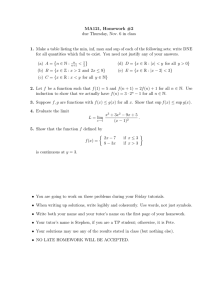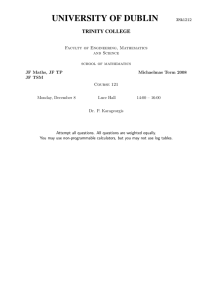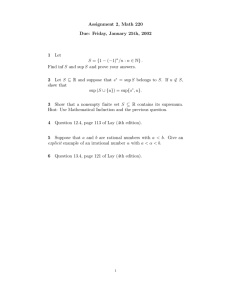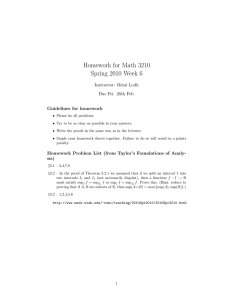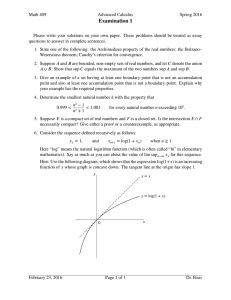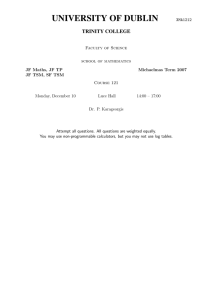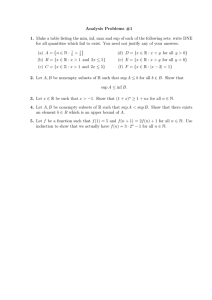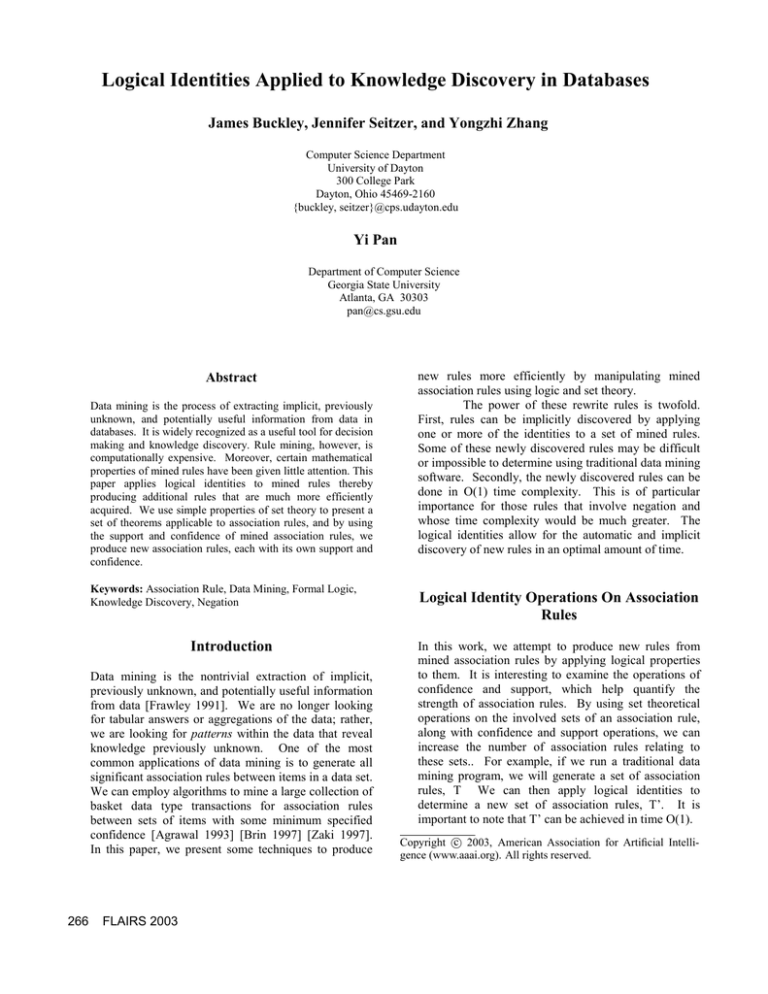
Logical Identities Applied to Knowledge Discovery in Databases
James Buckley, Jennifer Seitzer, and Yongzhi Zhang
Computer Science Department
University of Dayton
300 College Park
Dayton, Ohio 45469-2160
{buckley, seitzer}@cps.udayton.edu
Yi Pan
Department of Computer Science
Georgia State University
Atlanta, GA 30303
pan@cs.gsu.edu
Abstract
Data mining is the process of extracting implicit, previously
unknown, and potentially useful information from data in
databases. It is widely recognized as a useful tool for decision
making and knowledge discovery. Rule mining, however, is
computationally expensive. Moreover, certain mathematical
properties of mined rules have been given little attention. This
paper applies logical identities to mined rules thereby
producing additional rules that are much more efficiently
acquired. We use simple properties of set theory to present a
set of theorems applicable to association rules, and by using
the support and confidence of mined association rules, we
produce new association rules, each with its own support and
confidence.
Keywords: Association Rule, Data Mining, Formal Logic,
Knowledge Discovery, Negation
Introduction
Data mining is the nontrivial extraction of implicit,
previously unknown, and potentially useful information
from data [Frawley 1991]. We are no longer looking
for tabular answers or aggregations of the data; rather,
we are looking for patterns within the data that reveal
knowledge previously unknown. One of the most
common applications of data mining is to generate all
significant association rules between items in a data set.
We can employ algorithms to mine a large collection of
basket data type transactions for association rules
between sets of items with some minimum specified
confidence [Agrawal 1993] [Brin 1997] [Zaki 1997].
In this paper, we present some techniques to produce
266
FLAIRS 2003
new rules more efficiently by manipulating mined
association rules using logic and set theory.
The power of these rewrite rules is twofold.
First, rules can be implicitly discovered by applying
one or more of the identities to a set of mined rules.
Some of these newly discovered rules may be difficult
or impossible to determine using traditional data mining
software. Secondly, the newly discovered rules can be
done in O(1) time complexity. This is of particular
importance for those rules that involve negation and
whose time complexity would be much greater. The
logical identities allow for the automatic and implicit
discovery of new rules in an optimal amount of time.
Logical Identity Operations On Association
Rules
In this work, we attempt to produce new rules from
mined association rules by applying logical properties
to them. It is interesting to examine the operations of
confidence and support, which help quantify the
strength of association rules. By using set theoretical
operations on the involved sets of an association rule,
along with confidence and support operations, we can
increase the number of association rules relating to
these sets.. For example, if we run a traditional data
mining program, we will generate a set of association
rules, T We can then apply logical identities to
determine a new set of association rules, T’. It is
important to note that T’ can be achieved in time O(1).
c 2003, American Association for Artificial IntelliCopyright °
gence (www.aaai.org). All rights reserved.
Properties of association rules
In association rule mining, we use a database of sales
transactions to discover relationships among items. We
do this so that the presence of some items in a
transaction will imply the presence of other items in the
same transaction. To mine association rules, we extract
a subset of items that demonstrate such a relationship.
We then partition the subset into two, disjoint parts, the
antecedent and consequent, generating a rule of the
form X→Y, where X and Y are the respective parts.
We use and augment a traditional mathematical model
proposed in [Agrawal 1993] to formalize the problem
of data mining association rules. We also assume the
closed world assumption holds. Let I={i1, i2,…,in}be a
set of all items. Let D be a set of transactions, where
each transaction T is a set of items such that T is a
subset of I. Let X, Y⊂I be sets of items and X∩Y = ∅.
An association rule is an implication of the form X→Y,
meaning X implies Y. We say that the rule X→Y holds
in the transaction set D with confidence c if c% of
transactions in D that contain X also contain Y. The
rule X→Y has support s in D if s% of transactions in D
contain both X and Y. Thus, confidence denotes the
strength of implication, and support indicates the
frequencies of the occurring patterns in the rule
[Ramakrishnan 1998] [Chen 1996].
In part of our work, we extract certain items from the
antecedent (X) and consequent (Y) sets, and observe
the relationships involving the remaining sets. We
denote these extracted subsets as X’⊂
⊂X and Y’⊂
⊂Y,
respectively. All possible subsets of the extracted
elements can be represented by the set 2X’ (2Y’
respectively). Notice, all elements of 2X’ (2Y’ ) are also
elements of 2 I, thus, 2X’ ⊂ 2 I. A transaction that is
devoid of any extracted item is denoted T’⊂
⊂I. To
depict the collection of all such transactions (i.e.,
containing no extracted items), we introduce the new
operator, ‘tilde’.
Definition 1
The tilde, ~, operator depicts any transaction not
containing any element of X’ or Y’. That is,
~T’ =
2I
—
2X’
U Y’
Proof. By definition of confidence and our generalized
concept for rules (transaction relative), the item set A
implies A is always true. The confidence of the rule
A→A is 100% which is 1.
Sup(A → A) = N(A) / N
Proof. By definition of support and our generalized
concept for rules (transaction relative), the support of
the rule A→A is the fraction of transactions in the
database that contain all the items in the item set A.
This is N(A)/N.
Converse Properties. Let A and B be sets of items.
The confidence and support of the rule A→B are given
as follows:
Sup(B → A) = Sup(A → B)
Proof. This formula is true since all items in item sets
A and B are exactly all those items in item sets B and
A.
We now present four more properties. As these
properties are more intuitive and are similar to those
found in standard set theory, we do not provide proofs.
Commutative Properties.
The commutative
properties hold because the definition of support simply
combines the antecedent and consequent sets and
divides by the total number of transactions. Let A, B
and C be item sets. Then, we can specify the following
four formulas:
Sup(A ∩ B → C) = Sup(B ∩ A → C)
Sup(A ∪ B → C) = Sup(B ∪ A→
→C)
Con(A ∩ B → C) = Con(B ∩ A → C)
Con(A ∪ B → C) = Con(B ∪ A → C)
Associative Properties. Here, we appeal to the
associativity of union and intersection. Let A, B, C and
D be item sets. Then, we can specify the following four
formulas:
where 2I represents the set of all possible transactions.
Sup((A ∩ B) ∩ C → D) = Sup(A ∩ (B ∩ C) → D)
Identity Properties. Let A be a set of items, then the
confidence and the support of the rule A→A are given
as follows:
Sup((A ∪ B) ∪ C → D) = Sup(A ∪ (B ∪ C) → D)
Con(A → A) = 1
Con((A ∩ B) ∩ C → D) = Con(A ∩ (B ∩ C) → D)
Con((A ∪ B) ∪ C → D) = Con(A ∪ (B ∪ C) → D)
FLAIRS 2003
267
Distributive Properties. Let A, B, C and D be item
sets. Then, we can specify the following four formulas:
Sup(A ∪ (B ∩ C) → D) = Sup((A ∪ B) ∩ (A ∪ C) → D)
Sup(A ∩ (B ∪ C) → D) = Sup((A ∩ B) ∪ (A ∩ C) → D)
Con(A ∪ (B ∩ C) → D) = Con((A ∪ B) ∩ (A ∪ C) → D)
Con(A ∩ (B ∪ C) → D) = Con((A ∩ B) ∪ (A ∩ C) → D)
De Morgan’s Laws. We use ¬ to denote
complementation. Recall, the universe of transaction
items is the set of all possible items, I.
The
complement ¬A is simply I-A. Let A, B, and C be
item sets. Then, we can specify the following four
formulas:
Sup(¬ (A ∪ B) → C) = Sup(¬A ∩ ¬B → C)
Sup(¬ (A ∩ B) → C) = Sup(¬A ∪ ¬B → C).
Con(¬ (A ∪ B) → C) = Con(¬A ∩ ¬B → C)
Con(¬ (A ∩ B) → C) = Con(¬A ∪ ¬B → C).
Complement Properties. Let A, B, and C be item sets.
Then, we can specify the following four formulas:
Sup(A ∩ ¬A → C) = 0
Sup(A ∪ ¬A → C) = N(C) / N
Proof. By the closed world assumption, it is obvious
that the item set A∩¬A = ∅. Hence, the support of
A∩¬A → C is zero. Again, by the closed world
assumption, T = A∪¬A is every itemset, thus we have:
Sup(A ∪ ~A → C)
= N(T ∩ C) / N
= N(C) / N.
Contrapositive Properties. In traditional set theory,
by the contrapositive property, we have
(¬B→
→ ¬A) ↔ (A→
→ B)
We will now illustrate how, in data mining, the
contrapositive property holds via the mathematical
relations of support and confidence.
Let A B be item sets. We can specify the following two
theorems.
Theorem 1
268
FLAIRS 2003
Con(¬B → ¬A) = 1 – kc * (1 - Con(A → B))
where kc = N(A)/(N-N(B)), and N is the total number
of transactions.
Proof. By definition, and by the fact that N(¬B) = N N(B) is the total number of transactions that DO NOT
contain B, we have
Con(¬B→¬A)
= N(¬B ∩ ¬A) / N(¬B)
(by definition)
= N(¬A ∩ ¬B) / N(¬B)
(commute∩)
= N(¬A ∩ ¬B) / (N - N(B)) (substitution)
Notice that, by the closed world assumption, the total
number of transactions in the item set ¬A ∩ ¬B
equals the total number of transactions in the entire
dataset, minus N(A) + N(B) and less the overlapping
part which is N(A ∩ B). So, we have:
N(¬A ∩ ¬B) / (N - N(B))
= (N - (N(A) + N(B) - N(A ∩ B))) / (N - N(B))
(substitution)
=((N - (N(B) + N(A) - N(A ∩ B))) / (N - N(B))
(reorder)
=(N - N(B) - (N(A) - N(A ∩ B))) / (N-N(B))
=(N - N(B)) / (N - N(B)) – (N(A) - N(A ∩ B)) / (N N(B))
=1 – (N(A) - N(A ∩ B)) / (N - N(B))
(equivalence)
=1 - N(A) * (1 - N(A ∩ B) / N(A)) / (N - N(B))
(factor N(A) out)
=1 - (N(A) / (N - N(B)) * (1 - N(A ∩ B) / N(A))
=1 - kc(1 - Con(A → B))
(by definition)
Theorem 2
Sup(~B → ~A) = 1 – ks + Sup(A → B))
where ks = (N(A)+N(B))/N.
Proof. Similarly, by definition, we have
Sup(~B → ~A)
(by definition)
= N(~B ∩ ~A) / N
= N(~A ∩ ~B) / N
(commute ∩)
= (N - (N(A) + N(B) - N(A ∩ B))) / N
(substitution)
=N / N - (N(A) + N(B)) / N + N(A ∩ B) / N(A)
(partition sum)
=1 - ks + Sup(A → B).
(by definition)
Principles of Inclusion and Exclusion. Let A, B, and
C be item sets. We can specify the following four
theorems:
Theorem 3
Con(A → (B ∪ C)) =Con(A → B) + Con(A → C) Con(A → (B ∩ C))
Theorem 4
Sup(A → (B ∪ C)) = Sup(A → B) +
Sup(A →C) - Sup(A → (B ∩ C))
Theorem 5
Con((A ∪ B) →C) = k * (Con(C →
A) + Con(C → B) - Con(C →(A ∩ B)))
where k = N(C) / N(A ∪ B).
Theorem 6
Sup((A ∪ B) →C) = Sup(C →A) +
Sup(C →B) - Sup(C → (A ∩ B))
.
An Example
Introduction
A simple transaction database is shown in Table 1.
There are four item sets: A = Milk, B = Cereal, C =
Spoon, Bowl, and D = Soap. The transaction number is
labeled in the leftmost column and the items are labeled
as column headings.
1
2
3
4
5
6
7
Milk
Cereal
x
x
x
x
x
Spoon,
Bowl
x
x
x
x
Soap
x
x
x
x
x
= 1 – kc * (1 - Con(Milk → Cereal))
= 1 - (5 / (7 - 4)) * (1 – .6)
= .3
Sup(~Cereal → ~Milk)
= 1 – ks + Sup(Milk → Cereal))
= 1 - (5 + 4) / 7 + .43
= .14
Next, we examine the principles of inclusion and
exclusion. We additionally find that Con(Milk →
Spoon, Bowl) = .8 and Con(Milk → (Cereal ∩ Spoon,
Bowl)) = .4. Hence:
Con(Milk → (Cereal ∪ Spoon, Bowl))
= Con(Milk → Cereal) + Con(Milk → Spoon,
Bowl) - Con(Milk → (Cereal ∩ Spoon, Bowl))
= .6 + .8 – .4
=1
Sup(Milk → (Cereal ∪ Spoon, Bowl))
= Sup(Milk → Cereal) + Sup(Milk → Spoon,
Bowl) - Sup(Milk → (Cereal ∩ Spoon, Bowl))
= .43 + .57 – .29
= .71
Again, in Table 1, we find that Con(Spoon, Bowl →
Milk) = .8, Con(Spoon, Bowl → Cereal) = .4,
Con(Spoon, Bowl → (Milk ∩ Cereal)) = .4 and k = .83.
Hence:
Con((Milk ∪ Cereal) → Spoon, Bowl)
= k (Con(Spoon, Bowl → Milk) + Con(Spoon,
Bowl → Cereal) - Con(Spoon, Bowl → (Milk ∩
Cereal)))
= .83 (.8 + .4 – .4)
= .66
Similarly,
Sup((Milk ∪ Cereal) → Spoon, Bowl)
= .57 + .29 – .29 = .57
x
x
x
x
Table 1. A simple transaction database
From Table 1, we can determine the following:
N=7
N(Milk) = 5
N(Cereal) = 4
Con(Milk → Cereal) = .6
Sup(Milk → Cereal) = .43
Lastly, we examine De Morgan’s laws:
Sup(~(Milk ∪ Cereal) → Spoon, Bowl)
= Sup(~Milk ∩ ~Cereal → Spoon, Bowl) = .14
Sup(~(Milk ∩ Cereal) → Spoon, Bowl)
= Sup(~Milk ∪ ~Cereal → Spoon, Bowl) = .43
Illustration of logical identities. We first examine the
contrapositive properties:
Con(~Cereal → ~Milk)
FLAIRS 2003
269
Conclusions And Future Work
Conclusion
In this work, we produced new rules from mined
association rules by applying logical identities. Various
properties of rules were defined and proved, thus
providing the framework for a system of logical
identities. A new operator, tilde, was defined that
differentiates the concepts of set complementation and
negation. If we run a traditional data mining program,
we will generate a set of association rules, T We can
then apply logical identities to determine a new set of
association rules, T’. It is important to note that T’ can
be achieved in time O(1).
Future Work
The authors would like to expand upon the previously
described work by examining the potential for
generating predictive data mining rules that would be
based upon the probabilistic nature of the database
combined with transitivity of the identity rules. The
concept of negation in association rules is a novel
aspect of our work and we would like to continue to
investigate the generation and usefulness of such rules.
Lastly, the authors would like to examine the
incorporation of fuzzy logic concepts into the logical
identities to produce fuzzy association rules.
References
Agrawal, R, Imielinski, T., and Swami, A. “Mining
association rules between sets of items in large databases,”
ACM SIGMOD Bulletin, May 1993, pp. 207-216.
Brin, S., Motwani, R., Ullman, J., and Tsur, S. “Dynamic
Itemset Counting and Implication Rules for Market Basket
Data,” ACM SIGMOD, May 1997.
Chen, M., Han, J., and Yu, P. “Data Mining: An Overview
from a Database Perspective”, IEEE Transactions on
Knowledge and Data Engineering, Vol 8, No. 6, December
1996.
Frawley and Piatetsky-Shapiro, editors, Knowledge Discovery
in Databases, chapter Knowledge Discovery in Databases: An
Overview, AAAI Press/The MIT Press. 1991.
Ramakrishnan, R., Database Management Systems, McGrawHill, 1998.
Zaki, M., Parthasarthy, S., Ogihara, M., and Li,W. New
Algorithms for Fast Discovery of Association Rules”, 3rd
International Conference on Knowledge Discovery and Data
Mining, August 1997.
270
FLAIRS 2003

